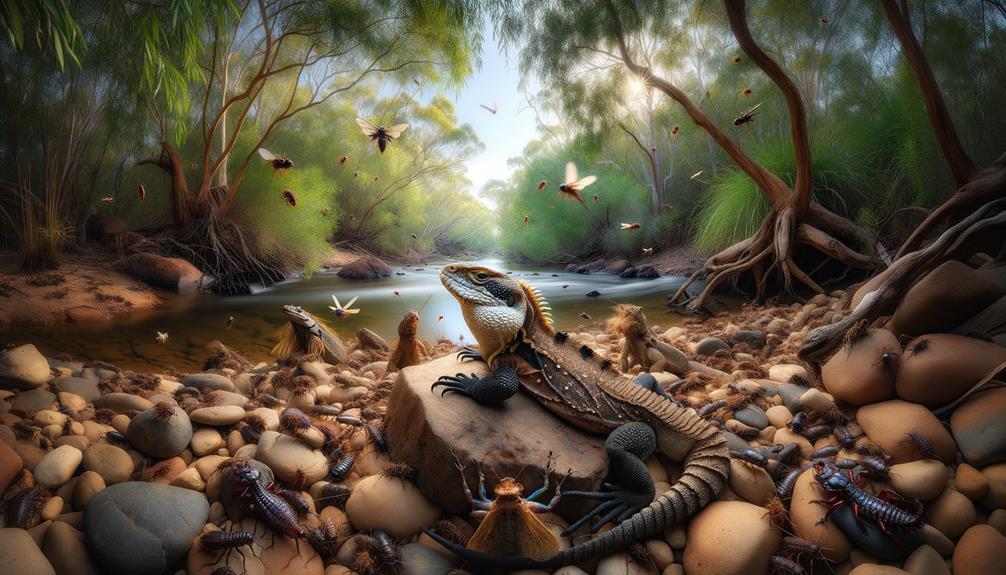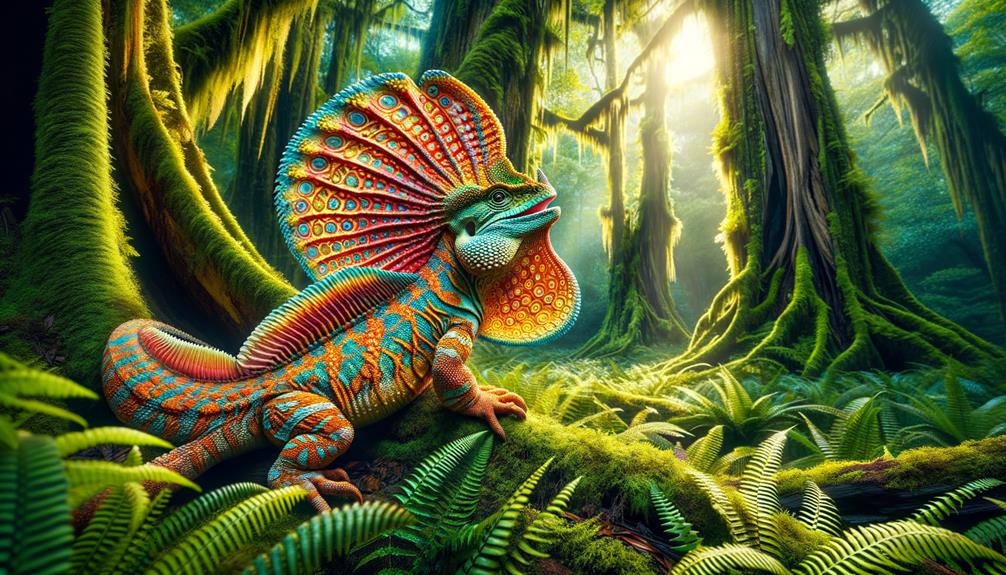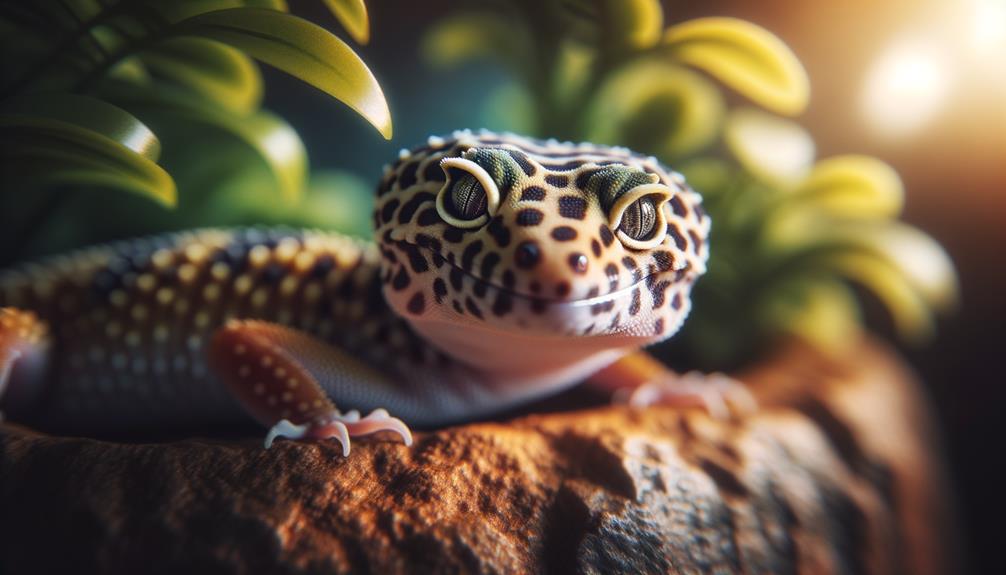I see frilled lizards as living fossils, remnants of a bygone era. When threatened, they stand upright on their hind legs, unfurl a vibrant 10-inch frill around their neck, and hiss with a wide, yellow-mouthed gape. Native to Australia, these remarkable creatures thrive in warm, humid climates, relying on termites as a food source during dry spells. Reaching up to 3 feet in length, their long tails aid in balance and swift escapes. They breed during the rainy season, with incubation depending on environmental temperatures. While currently listed as Least Concern by the IUCN, habitat loss and feral cats pose significant threats to their survival. Let's delve deeper into their incredible evolution and survival skills.
Key Takeaways
Frilled lizards boast a one-of-a-kind defense mechanism – unfurling their neck frill to deter predators. Their ability to sprint on hind legs for a quick getaway is an impressive adaptation. The frill also plays a role in regulating body temperature, showcasing its multifaceted nature. These lizards thrive in Australia's tropical forests and savannas, demonstrating their adaptability to diverse environments. With their long lifespan and temperature-dependent sex determination, they exhibit complex reproductive strategies.
Defensive Behavior
When faced with a predator, the frilled lizard resorts to a dramatic display of defense. It rises onto its hind legs, unfurls its vibrant, blood vessel-rich frill around its neck, and opens its yellow mouth wide, letting out a menacing hiss. This startling visual display is meant to intimidate potential threats.
The frill serves a dual purpose, as it also plays a crucial role in regulating the lizard's body temperature. When the situation demands a quick escape, the frilled lizard can rapidly accelerate on its hind legs, using its strong, splayed limbs to dart towards the nearest tree. This agility is not only impressive but also a critical survival strategy.
The unique combination of the frill, gaping mouth, and ability to stand on hind legs makes the frilled lizard a fascinating subject of study. Its remarkable adaptations have evolved to navigate and thrive in its environment, showcasing a remarkable ability to survive and adapt.
Habitat and Diet

Frilled lizards thrive in the warm, humid environments of northern Australia's tropical and temperate forests, as well as the savannas. Their arboreal lifestyle and sharp climbing claws make them agile navigators of eucalyptus trees. They spend most of their lives high in the canopy, blending seamlessly with their surroundings. When it's time to eat, they descend to the forest floor, demonstrating impressive agility and stealth.
Their diet consists mainly of insects and other invertebrates. During the dry season, termites become a crucial food source, providing essential nutrients when other prey might be scarce. In the wet season, moth larvae become a valuable protein-rich food source. Frilled lizards also consume ants, small lizards, spiders, cicadas, and occasionally small mammals. They employ a sit-and-wait strategy, patiently perching until the perfect moment to strike.
The frilled lizards' arboreal nature is evident in their physical adaptations. Sharp claws allow them to climb with ease, ensuring they can swiftly return to the safety of the trees after feeding. This lifestyle requires balance and precision, perfectly suited to their unique habitat.
Size and Appearance

Measuring up to 3 feet in length and weighing around 1.1 pounds, frilled lizards are quite remarkable. Their distinctive frill, which can expand to over 10 inches when threatened, is a striking feature. The long tail aids in balance and swift movement, especially when escaping predators.
The neck frill is not just for show; it serves as a defense mechanism and means of communication. When a frilled lizard feels threatened, it unfurls this colorful, membrane-like structure, creating a spectacular display that can intimidate even larger lizards and predators.
| Feature | Description |
|---|---|
| Length | Up to 3 feet from head to tail |
| Weight | Around 1.1 pounds |
| Neck Frill | Expands to over 10 inches when threatened |
| Claws | Sharp, aiding in expert climbing abilities |
A frilled lizard's gaping mouth reveals two pairs of long fangs on both the top and bottom jaws, adding to their fearsome appearance. It's clear that frilled lizards have evolved a suite of physical traits that make them truly unique in the reptile world.
Reproduction and Lifespan

Breeding during the late dry and early wet seasons, frilled lizards exhibit fascinating reproductive behaviors that guarantee the continuation of their species. These intriguing reptiles dig shallow cavities in the earth, where females lay anywhere from 4 to over 20 eggs per clutch. Notably, the number of eggs correlates with the size of the female; smaller frilled lizards produce fewer eggs, while larger ones can lay more.
The incubation period for these eggs ranges from 2 to 4 months, depending on environmental conditions. Temperature plays a pivotal role in determining the sex of the hatchlings. Milder temperatures generally result in more male offspring, while extreme temperatures produce more females. This temperature-dependent sex determination is a remarkable adaptation seen in other reptiles as well.
In captivity, frilled lizards can live up to 20 years, though their lifespan in the wild remains unknown. Despite being listed as Least Concern by the IUCN, there are warnings of local population declines in some areas. Understanding their breeding patterns and incubation needs is crucial for conservation efforts, ensuring these prehistoric marvels continue to thrive in their natural habitats.
Threats to Survival

Understanding the reproductive behaviors of frilled lizards is vital, but it's equally crucial to address the significant threats they face in their natural habitats. Despite being listed as Least Concern by the IUCN, frilled lizards have their challenges. Their primary predators include birds of prey, larger lizards, snakes, dingoes, and feral cats. Feral cats, in particular, pose a substantial threat to their populations in certain regions.
Habitat reduction also plays a critical role in influencing their survival. Frilled lizards inhabit tropical and warm temperate forests as well as savanna woodlands in northern Australia. However, human activities like deforestation are shrinking these habitats, leaving frilled lizards with fewer places to call home.
Here's a quick overview of the threats:
| Predator/Threat | Impact on Frilled Lizards |
|---|---|
| Birds of prey | Major predators, affect population size |
| Feral cats | Significant population decline in areas |
| Habitat reduction | Loss of living spaces, affects survival |
Frilled lizards may not be endangered, but the combination of habitat loss and predation by non-native species like feral cats can seriously impact their numbers. Raising awareness and conservation efforts are necessary to ensure these prehistoric creatures continue to thrive.
Frequently Asked Questions
What Did the Frilled Lizard Evolve From?
Imagine the frilled lizard's ancestors gliding through ancient skies. They evolved from reptiles like Icarosaurus and Kuehneosaurus of the Mesozoic Era, developing unique traits to evade predators and communicate effectively.
Did Dilophosaurus Actually Have a Frill?
Dilophosaurus didn't actually have a frill. Fossil records show that it lacked the necessary hyoid bones and muscles. The iconic frill and venomous spit we associate with the dinosaur were creative liberties taken by the Jurassic Park franchise, not rooted in scientific fact.
What Is the Dinosaur That Looks Like a Frilled Lizard?
The dinosaur that resembles a frilled lizard is the Dilophosaurus, although it's a bit of a misconception. Unlike the frilled lizard, Dilophosaurus didn't have a frill or spit venom, but its unique appearance still sparks curiosity.
Are Frilled Dragons Dinosaurs?
Frilled dragons aren't dinosaurs. They're modern reptiles belonging to the genus Chlamydosaurus. While they share some physical traits with certain dinosaurs, they're evolutionarily distinct, having developed their signature frill for defense and communication.



